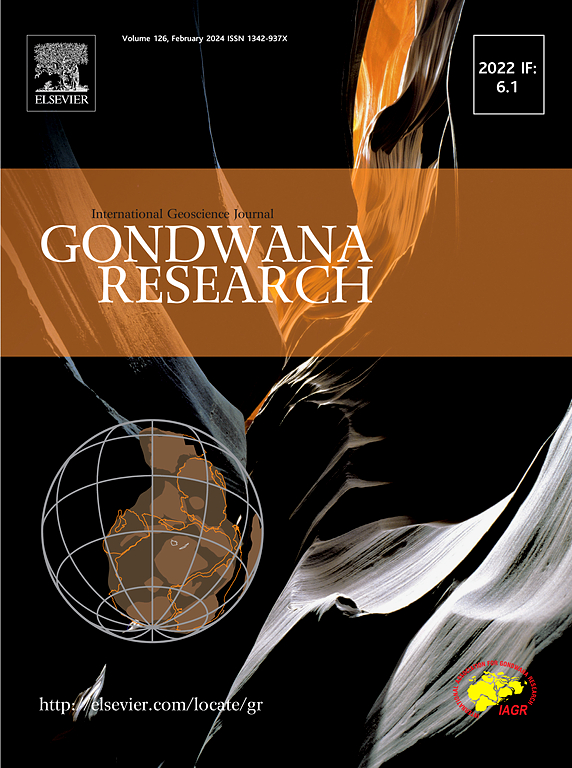Tectonic evolution of the Amerasia Basin, Arctic Ocean
IF 7.2
1区 地球科学
Q1 GEOSCIENCES, MULTIDISCIPLINARY
引用次数: 0
Abstract
The tectonic evolution of the Arctic Ocean remains debated. We present a new interpretation of selected seismic profiles for the Amerasia Basin. We extend and correlate the seismic stratigraphy for the area from the Alpha-Mendeleev Rise to the Canada Basin. The seismic stratigraphy is tied to isotope ages of volcanic rocks. It shows that the Canada Basin postdates formation of the Alpha-Mendeleev Rise. We distinguish the following stages in the formation of the Amerasia Basin: Stage 1. Jurassic-Neocomian formation of continental rifts. Stage 2. Barremian (Aptian)-Albian (125–100 Ma) large-scale extensional tectonics and magmatism in the Alpha-Mendeleev Rise and adjacent basins, formation of SDR-type complexes and failed passive volcanic continental margins. Continental rifting occurs with local formation of SDR-type complexes in the future Canada Basin. Stage 3. Late Cretaceous (100–70 Ma) back-arc opening of the Canada Basin with rotation of Alaska toward the Pacific Ocean. Transitional crust and highly stretched (hyper-extended) continental crust formed first, followed by oceanic crust. Sea-floor spreading propagated toward the Nautilus Basin and the Alpha-Mendeleev Rise. Large submarine volcanoes formed during late stages of the opening. Stage 4. ca. 70–56 Ma formation of graben systems in the 78˚N Basin, Stefansson Basin, north and east of the Chukchi Borderland. Stage 5. Cenozoic general subsidence of the basin and formation of normal faults north of the Chukchi Borderland. Amerasia Basin formation began just after the end of the Verkhoyansk-Chukotka collision orogeny and South Anyui Ocean closure, simultaneously with orogenic collapse.

北冰洋美亚西亚盆地的构造演化
北冰洋的构造演化至今仍有争议。本文提出了对美亚拉西亚盆地地震剖面的一种新的解释。本文对该地区从阿尔门捷列夫隆起到加拿大盆地的地震地层学进行了扩展和对比。地震地层学与火山岩的同位素年龄有关。这表明加拿大盆地的形成时间晚于α -门捷列夫隆起。我们将美亚西亚盆地的形成分为以下几个阶段:第一阶段;侏罗纪-新新世大陆裂谷的形成。阶段2。α -门捷列夫隆起及其邻近盆地的巴雷米亚(阿普田)-阿尔比尼亚(125-100 Ma)大规模伸展构造和岩浆活动,形成了特殊类型杂岩和失败的被动火山大陆边缘。在未来的加拿大盆地,大陆裂谷作用与局部形成的sdr型杂岩同时发生。阶段3。晚白垩纪(100-70 Ma)加拿大盆地弧后开口,阿拉斯加向太平洋旋转。首先形成过渡性地壳和高度伸展(超伸展)的大陆地壳,其次是海洋地壳。海底向诺第留斯海盆和门捷列夫隆起扩展。大型海底火山形成于火山开放后期。阶段4。楚科奇边地北部和东部的78˚N盆地、Stefansson盆地约70-56 Ma地堑体系的形成。第五阶段。楚科奇北缘新生代盆地总体沉降与正断层的形成。美亚盆地的形成是在Verkhoyansk-Chukotka碰撞造山运动和南安义洋闭合结束后开始的,与造山崩塌同时发生。
本文章由计算机程序翻译,如有差异,请以英文原文为准。
求助全文
约1分钟内获得全文
求助全文
来源期刊

Gondwana Research
地学-地球科学综合
CiteScore
12.90
自引率
6.60%
发文量
298
审稿时长
65 days
期刊介绍:
Gondwana Research (GR) is an International Journal aimed to promote high quality research publications on all topics related to solid Earth, particularly with reference to the origin and evolution of continents, continental assemblies and their resources. GR is an "all earth science" journal with no restrictions on geological time, terrane or theme and covers a wide spectrum of topics in geosciences such as geology, geomorphology, palaeontology, structure, petrology, geochemistry, stable isotopes, geochronology, economic geology, exploration geology, engineering geology, geophysics, and environmental geology among other themes, and provides an appropriate forum to integrate studies from different disciplines and different terrains. In addition to regular articles and thematic issues, the journal invites high profile state-of-the-art reviews on thrust area topics for its column, ''GR FOCUS''. Focus articles include short biographies and photographs of the authors. Short articles (within ten printed pages) for rapid publication reporting important discoveries or innovative models of global interest will be considered under the category ''GR LETTERS''.
 求助内容:
求助内容: 应助结果提醒方式:
应助结果提醒方式:


